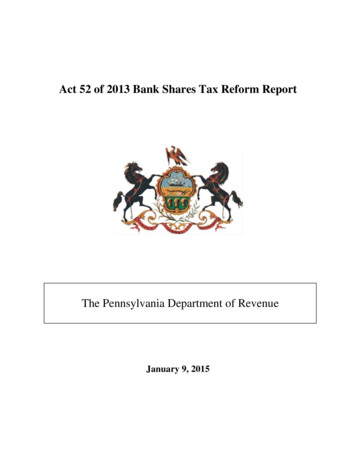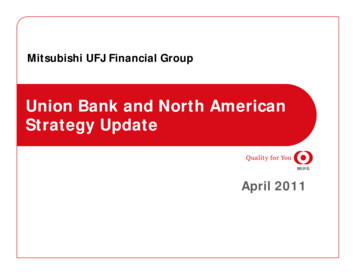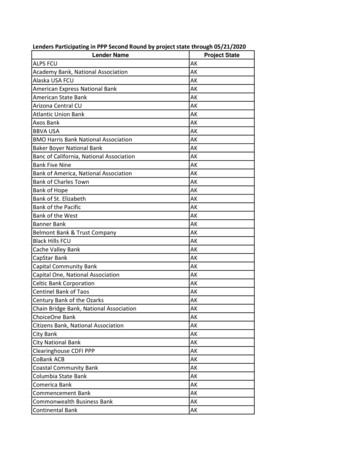
Transcription
Act 52 of 2013 Bank Shares Tax Reform ReportThe Pennsylvania Department of RevenueJanuary 9, 2015
Table of ContentsExecutive SummaryIntroductionPennsylvania Financial Institutions TaxesChanging Regulations in the Financial IndustryBackgroundBank Shares Tax and the Development of Act 52 of 2013Detailed Review of Act 52 of 2013Page13357710Tax BaseTax LiabilitiesRate of TaxApportionment10Summary of Issues20Goodwill DeductionApportionmentGross Receipts ThresholdTaxpayer DefinitionsMutual Thrift Institutions TaxAnalysis of Fiscal Year 2013-14 Cash CollectionsOptions to Increase RevenuesSummary of RecommendationsProposed Draft LegislationRecommendation #1Recommendation #2Recommendation #3Recommendation #4Recommendation #5Recommendation #6111316202123232627293031323638394345
List of AppendicesAppendix A: Summary of 2013 and 2014 Bank Shares Tax Return DataAppendix B: Summary of 2013 and 2014 Bank Shares Tax Return Databy StateAppendix C: Summary of 2013 and 2014 Bank Shares Tax Return Databy Size of InstitutionAppendix D: 2014 Rates of Tax on Banks and Apportionment Formulasfor Bank TaxesAppendix E: Crowe Horwath Report on State Bank TaxesAppendix F: Bank Shares Tax Receipts Factor Calculation3
Act 52 of 2013 Bank Shares Tax Reform ReportExecutive SummaryThe Act of July 9, 2013 (P.L. 270, No. 52) requires a detailed report to determinewhether the changes to the Bank and Trust Company Shares Tax therein sufficientlyaddressed the significant changes in the structure and regulatory environment within thebanking industry and provided predictable tax revenues. To that end, the PennsylvaniaDepartment of Revenue, working jointly with the Department of Banking and Securitiesand representatives from the banking industry in this commonwealth, has produced thisdocument.Act 52 (“the Act”) made the following major changes to the Bank and Trust CompanyShares Tax: Reduced the tax rate from 1.25 percent to 0.89 percentChanged the tax base from “total equity capital” to “total bank equity capital”Eliminated the use of a six-year average of total equity capital to calculate the taxbaseBased apportionment solely on receiptsAmended the receipts factor to heavily favor customer-based sourcing, rather thansourcing based on the state where the service originatedExpanded the extent to which out-of-state bank and trust companies doingbusiness in Pennsylvania are subject to taxThe Commonwealth of Pennsylvania is a diverse banking state with a number ofcommunity banks, savings banks, regional banks, large banks with a statewide presence,out-of-state banks with branches in the commonwealth, and many credit unions. Recenthistory has seen significant changes within the regulatory and structural environment inwhich these institutions exist. Increased capital requirements and evolving customerneeds have put pressures on the industry and created a need to adapt.Within Pennsylvania, these institutions are subject to several different taxes depending onthe type of financial activity and ownership structure of the institution. The Act amendedthe Bank and Trust Company Shares Tax (Bank Shares Tax), but it has brought to lightthe need for greater scrutiny of what types of entities should be subject to which tax. Forinstance, some large stock institutions with similar structure and practices as banks maybe subject to the Mutual Thrift Institutions Tax when this tax was originally intended formutually owned, non-stock thrifts. For most institutions, the tax liability under theMutual Thrift Institutions Tax is less than it would be under the Bank Shares Tax. Alsoof note, credit unions are not currently subject to an income or stock-based tax in thecommonwealth.Pennsylvania Department of RevenuePage 1
Act 52 of 2013 Bank Shares Tax Reform ReportOther issues identified in this report include the need for clarification of the goodwilldeduction in the Act and a need for clarification of the apportionment of investment andtrading receipts. There is also a disparity between the tax base and the apportionmentfactor calculation used to determine the Bank Shares Tax, and a need for clarificationregarding the tax treatment of banks with no physical presence in Pennsylvania and lessthan 100,000 of receipts from Pennsylvania sources. The report also finds that theoverall effective rate in Pennsylvania remains higher than in competing and contiguousstates, but makes no recommendations regarding additional tax revenue.Included in this report are the following technical recommendations:1. Clarify the current apportionment language allowing Method 1 apportionment forbanks with receipts from trading assets/activities and not investmentassets/activities.2. Clarify whether the deduction for goodwill is also allowed against the tax base,and not just in calculating the deduction for United States obligations.3. Correct the mismatch of definitions between the tax base (consolidated reports ofcondition) and apportionment (separate company federal tax figures). Themismatch creates legal and reporting issues and opens opportunities for taxplanning.4. Repeal Tax Reform Code section 701.4(3)(xiii)(E) allowing for separateapportionment for different types of investment and trading receipts.5. Eliminate the requirement that banks have 100,000 in Pennsylvania sourcedreceipts in order to be subject to Bank Shares Tax. Under current law it ispossible that such banks could be subject to the Corporate Net Income Tax(CNIT) and franchise taxes. It is recommended that this change be accompaniedby the option to file a de minimis report for banks with limited presence in thestate.6. Strengthen the taxpayer definitions and apportionment provisions of the MutualThrift Institutions Tax. This action should be taken to prevent large credit cardcompanies from avoiding the Bank Shares Tax by forming as savings institutions,while preserving this structure as a benefit to Pennsylvania mutually owned, nonstock thrifts.Pennsylvania Department of RevenuePage 2
Act 52 of 2013 Bank Shares Tax Reform ReportIntroductionPennsylvania is a diverse banking state with a desirable mix of community banks, savingsbanks, regional banks, large banks with a statewide presence, out-of-state banks withbranches in the commonwealth, and more credit unions than all but one state. Theseinstitutions are at the core of the commonwealth’s credit cycle performing the essentialfunctions of linking depositors and borrowers. Serving individuals, businesses large andsmall, agriculture, non-profits and government, they provide a safe place to depositmoney and make loans, contributing directly to the economic vitality of theircommunities. They also provide jobs in their communities and, if stock-owned, generatereturns for shareholders promoting economic growth.There are 95 state chartered banks, 50 state chartered savings banks, and 16 statechartered non-depository trust companies headquartered in the commonwealth. Theseinstitutions have approximately 153 billion in assets, 2,420 branch offices, and employ26,000 people in Pennsylvania.There are 28 national banks, 20 federally chartered savings banks (savings and loanassociations), and 4 federally chartered non-depository trust companies headquartered inPennsylvania. These institutions have approximately 71 billion in assets, about 800branch offices, and employ about 14,000 people. State and federally chartered banksbased in the commonwealth hold approximately 150 billion in loans.There are 26 banks and 3 savings banks headquartered outside of the commonwealth thathave branches in Pennsylvania. These institutions employ approximately 20,000 peoplein Pennsylvania.There are 56 state chartered credit unions with approximately 11 billion in assets and415 federally chartered credit unions with approximately 29 billion in assets located inthe commonwealth. There are at least 21 credit unions headquartered in other states thathave operations here.The Department of Banking and Securities is also aware of 16 credit card banks based inother states and as many as 10 industrial banks (loan companies) that do business withPennsylvania customers.Pennsylvania Financial Institutions TaxesIn Pennsylvania, financial institutions are not subject to the corporate income tax, butinstead are subject to several different taxes. These taxes have very different bases andrates, but do not include credit unions which are not currently subject to tax. The result iswidely varying tax burdens on different segments of the financial sector.Pennsylvania Department of RevenuePage 3
Act 52 of 2013 Bank Shares Tax Reform ReportBanking institutions having capital stock and conducting business in Pennsylvania1 aresubject to the Bank Shares Tax on the apportioned value of bank net equity. This tax isdiscussed in more detail following this section, and is the primary focus of this report.Mutual thrift institutions, including savings institutions, savings banks, savings and loanassociations, and building and loan associations conducting business in Pennsylvania,are subject to the Mutual Thrift Institutions Tax. This tax applies a rate of 11.5 percent tothe net earnings or income received or accrued from all sources during the tax year.Income earned from United States obligations or Pennsylvania state and local obligationsis excluded from the computation of net earnings on income. Additionally, no deductionis permitted for the amount of interest expense related to tax-exempt income.Apportionment of income to Pennsylvania is permitted through payroll, receipts, anddeposits factors. Mutual thrift institutions are permitted to carry forward net operatinglosses for a maximum of three years.Total revenues from the Mutual Thrift Institutions Tax were 10.7 million in fiscal year2013-14. Revenues from this source have declined as thrifts continue to convert to ormerge with commercial banks.Pennsylvania also imposes a gross receipts tax on private bankers in this commonwealthat the rate of 1.00 percent on gross receipts from commissions, discounts, abatements,allowances, and all other receipts arising from business. There is only one entity subjectto the Private Bankers Tax.The varying tax treatment of these financial institutions primarily arises from the form ofownership of the business, and the charter under which they are formed. A bank isdefined as formed under the banking law, having capital stock and operating to make aprofit for its shareholders. In general, a mutual thrift institution has a mutual form ofownership, meaning that it is owned by its members, though there are some thrifts thathave issued stock. Credit unions also have a mutual form of ownership and are classifiedby state law as savings institutions, but are exempt from most types of taxes by federaland state law. The Department estimates that the tax exemption for credit unions fromthe Mutual Thrift Institutions Tax reduces revenues by 26.3 million annually.Federally chartered credit unions are exempt under federal law from all federal, state, andlocal taxes, except for taxes on real property and tangible personal property. Federal lawpermits states, however, to impose personal property taxes on the holders of shares infederally chartered credit unions, provided that such taxes are also imposed on holders ofshares of state chartered credit unions. Credit unions chartered by the commonwealth areexempt under state law from all state and local taxes except real property taxes.1This report will refer to “institutions” as defined in Article VII of the Tax Reform Code as “banks,” todistinguish them from other types of financial institutions.Pennsylvania Department of RevenuePage 4
Act 52 of 2013 Bank Shares Tax Reform ReportAll of these organizations (with the exception of private banks) pay for and are coveredby deposit insurance from one of two federal agencies: the Federal Deposit InsuranceCorporation (FDIC) or the National Credit Union Administration (NCUA).However, as will be discussed in detail later in this report, the traditional linesdistinguishing these types of financial institutions have become blurred over time, so thatsimilar institutions are now more likely to be subject to different taxation by thecommonwealth.Changing Regulations in the Financial IndustryThe banking industry has been under stress since the banking crisis in 2008, onlyimproving recently as the economy has slowly been recovering from a deep recession.However, Pennsylvania’s banking institutions were able to avoid many of the mostnegative effects that the economic downturn inflicted on banks in other regions of thecountry.Pennsylvania banks have not been immune to the industry consolidation seen in manyother states, however. There are approximately 46 fewer banks, 27 fewer savings banksand savings and loan associations and nine fewer non-depository trust companies basedin the commonwealth than there were 10 years ago. Credit union numbers have beenreduced by 230 during the same period. There has been, however, significant growth inthe number of out-of-state banks and credit unions operating in the commonwealth duringthe past ten years. The consolidation of the Pennsylvania banking industry is expected tocontinue, along with the expansion of out-of-state banks operating in the commonwealththrough acquisitions and branching.The Dodd-Frank Wall Street Reform and Consumer Protection Act (the “Dodd-FrankAct”) was signed into law by President Obama in July 2010. The Dodd-Frank Actrequires depository institutions, including banks and their holding companies, to adhereto minimum leverage and minimum risk-based ratios that must be no less than the ratiosimposed by the federal bank regulatory agencies in effect at the time of the passage of theDodd-Frank Act. Institutions subject to the Dodd-Frank Act are likely to consolidateoperations under the banks to meet the minimum ratios required by the Dodd-Frank Act.As the institutions’ consolidated equity increases, institutions’ Pennsylvania Bank SharesTax liability will likely increase.Set forth by the Federal Reserve in 2006, Regulation K requires banks’ foreignsubsidiaries, as well as other foreign investments, be held through a special type of entityknown as an “Edge Act corporation.” An Edge Act corporation acts as a holdingcompany for the bank’s foreign investments and conducts other permitted overseasactivities, directly or indirectly.2 This has a similar effect as the Dodd-Frank Act in that itrequires the Pennsylvania Bank Shares Tax to include an institution’s consolidated equity2Reg K-- 12 C.F.R. § 211, implements Section 25A of the Federal Reserve Act. See 12 U.S.C. §§ 611-631.Pennsylvania Department of RevenuePage 5
Act 52 of 2013 Bank Shares Tax Reform Reportin the tax base but does not allow the institution to use the apportionment factors of itssubsidiaries. The Edge Act issue affects a very limited number of the larger, morecomplex banks that do business in the commonwealth.Pennsylvania banks continue to face 21st century challenges including changing federalregulatory regimes and more complicated and expensive compliance requirements,capital ratios that will likely continue to increase under federal regulations andinternational requirements, increasing competition from out-of-state banks, technologicalinnovations, and evolving customer demands.For example, the new Consumer Financial Protection Bureau (CFPB) was put in placeunder the Dodd-Frank Act with a stated mission of providing consumers information tounderstand their agreements with financial institutions.Another example of recent operational challenges for banks is the increase in leverageratios. Tier 1 (Core) Capital is used to measure a bank’s financial strength from aregulator’s point of view – it is regulatory capital. This includes common stock, retainedearnings, and some equity-like non-redeemable preferred shares. Core Capital (leverage)ratios (equity capital as a share of total assets) have increased from 7.82 percent in 2009to 10.20 percent in 2014 for all Pennsylvania charters.The Third Basel Accord (Basel III) is a global regulatory agreement establishingstandards for adequacy of bank capital, stress testing, and liquidity. The accord wasdeveloped in response to the 2008 global financial crisis which exposed regulatory gapsand inconsistencies internationally. The intent of the accord is to strengthen capitalrequirements for all banks by requiring increased liquidity and decreased leveragestandards.Federal and international regulations like Basel III will continue to require increasedlevels of capital. This will have the effect of increasing the tax base for many banks.With the evolving regulatory and financial environment, the Bank Shares Tax should be astable, reasonably predictable, and fair tax that is competitive with other states taxes. Thetax should also encourage Pennsylvania banks to maintain their locations in Pennsylvaniaand make Pennsylvania an attractive state for banks from other states.Pennsylvania Department of RevenuePage 6
Act 52 of 2013 Bank Shares Tax Reform ReportBackgroundBank Shares Tax and the Development of Act 52 of 2013The Bank Shares Tax is an annual tax imposed on every bank and trust company, havingcapital stock, which is conducting business within the commonwealth. The tax is basedon the value of shares as of each January 1st. A report and payment of 100 percent of thetax on the value of shares on the preceding January 1st are due on March 15th of eachyear. Banks can apply for a six month extension to file their return, but the tax liabilityremains due on March 15th.The development of the Act began when the Pennsylvania Bankers Association (PBA)met with executive staff of the Pennsylvania Department of Revenue (“the Department”)in May 2012 to present a proposal entitled “Recommendations For Changes ToPennsylvania Bank Shares Tax.” The summary stated the following major objectives: Modify the tax to solve the problems with the use of a six-year moving averageidentified in the Lebanon Valley Farmers Bank3 case (described later).Create greater incentives to develop and expand banking facilities inPennsylvania.Make possible substantial rate reductions by expanding the extent to which out ofstate banks are subject to the tax.The initial PBA proposal made the following major changes: 3Reduced the tax rate for 2013 from 1.25 percent to 0.55 percent, and provided aprocess for calculating a tax rate to reach 238 million in fiscal year 2012-13revenue. The Department would publish a revised tax rate by May 1 each year tobring revenue up to the target amount. The tax rate would be calculated based onactual revenue received at the March 15th due date.Eliminated the use of the six-year moving average in calculating the value of bankshares to resolve the Lebanon Valley Farmers Bank case.Adopted the use of “total bank equity” instead of “total equity” capital.Shifted to 100 percent reliance upon receipts for apportionment, phased in over afour-year period.Apportioned receipts based on the recommendations of the Multi-state TaxCommission, with modifications to use market-based sourcing of receipts fromservices and for other payments.Required any institution actively soliciting business in Pennsylvania or withemployees or agents operating in the state to pay the Bank Shares Tax.Repealed limitations on appeal petitions regarding the Bank Shares Tax.Specifically, banks would no longer need to pay an assessment before beginningthe appeals process.Lebanon Valley Farmers Bank v. Commonwealth of Pennsylvania, 83 A.3d 107 (Pa. 2013).Pennsylvania Department of RevenuePage 7
Act 52 of 2013 Bank Shares Tax Reform ReportA modified version of the amendment was incorporated into the omnibus Tax ReformCode bill, House Bill 465. After receiving approval in both chambers of the GeneralAssembly, HB 465 was signed by Governor Corbett on July 9, 2013, becoming Act 52.The Act provided that beginning January 1, 2014, the tax rate on the dollar value of eachtaxable share of stock was reduced from 1.25 percent to 0.89 percent.4 The 1.25 percentrate had been in effect since 1990.Prior to January 1, 2014, the value of shares was calculated by a six-year moving averageof total equity capital, with a proportional exemption for United States obligations. Foreach year in the average, total equity capital and deductions for United States obligationswere determined by averaging the values as shown in the Report of Condition for eachquarter of the preceding calendar year.As of January 1, 2014, the value of shares is the total bank equity capital, with aproportional exemption for United States obligations.5 Total bank equity capital anddeductions for United States obligations are determined by the most recent year-endvalues as shown in the Report of Condition.Apportionment is now based solely on receipts, rather than on payroll, receipts, anddeposits. The receipts factor is also re-defined to heavily favor customer-based sourcing,rather than sourcing based on the location of bank offices.6 This is similar to the mannerin which CNIT is apportioned based on sales using market-based sourcing. The term“sourcing” is used to describe the location where a receipt is assigned for tax purposes.The Act also expanded the number of taxpayers by adding a new definition of “doingbusiness in this Commonwealth,” extending the tax to banking institutions that generateat least 100,000 of gross receipts apportioned to Pennsylvania. It also removed thelanguage, “located within this Commonwealth” from the definition of an institution andexpanded it to include foreign depositories. 7 These changes are generally described as an“economic nexus” standard, indicating that tax may be required from banks witheconomic ties to Pennsylvania, but that may not have a direct physical presence.The Act also required this detailed report to determine whether the Act’s changes to theBank Shares Tax sufficiently addressed the significant changes in the structure andregulatory environment within the banking industry and provided predictable taxrevenues. This report is to be provided to the chairmen and minority chairmen of theAppropriation and Finance Committees of both the Senate and the House ofRepresentatives.4See 72 P.S. 7701(b).See 72 P.S. 7701.1.6See 72 P.S. 7701.4.7See 72 P.S. 7701.5.5Pennsylvania Department of RevenuePage 8
Act 52 of 2013 Bank Shares Tax Reform ReportThe Act was scored to be close to revenue neutral. Fiscal year 2013-14 Bank Shares Taxcollections were forecasted to be 352.1 million before the Act, and 351.5 million afterthe reform was in place. The actual collections for fiscal year 2013-14 were 307.2million. A discussion of the reasons for that shortfall is included in this report.Pennsylvania Department of RevenuePage 9
Act 52 of 2013 Bank Shares Tax Reform ReportDetailed Review of Act 52 of 2013Tax BaseThe federal government, as with most other states, taxes banks on net income like othercorporations. Pennsylvania taxes banks based on their equity capital, which is a measureof a bank’s net worth, taking the current market value of everything a bank owns andsubtracting liabilities. It is likely that a net worth tax is more stable than an income tax,because net income is more volatile than net worth.8The Act eliminated the use of a six-year average to calculate the value of total equitycapital. It also changed the balance sheet line item upon which the value is calculatedfrom total equity capital to total bank equity capital. Changing from a six-year average toa spot tax on the bank equity for a single quarter may make the tax base somewhat morevolatile. However, this change also increases the tax base by eliminating historical equity– which is most often lower than current equity – from the calculation. As a result, thevalue of shares (before apportionment) for all banks rose by 31.5 percent between 2013and 2014.The legislative changes were enacted prior to a final decision of the PennsylvaniaSupreme Court on the constitutionality of the application of the six-year averagingprovision as it applied to bank acquisitions and mergers in the Lebanon Valley FarmersBank case.9 In this case, the taxpayer claimed that the uniformity rule of the Constitutionwas violated by requiring the six-year history of the taxable value of shares to include thevalue of acquired Pennsylvania banks. Pursuant to a prior decision of the Court10, thevalue of acquired non-Pennsylvania banks was excluded from the history of values.Ultimately, the Court held the disparate treatment afforded acquisitions of Pennsylvaniabanks under the First Union rule did not violate constitutional standards.The change from total equity capital to total bank equity capital stems from FinancialAccounting Standards Board’s (FASB) December 2007 adoption of new standardsaffecting the consolidation of entities and the reporting of minority interest.11 The termminority interest was changed to non-controlling interest to reflect the new standard forconsolidation based on control rather than predominantly on a majority ownershippercentage. A non-controlling interest is the portion of equity in a subsidiary notattributable, directly or indirectly, to the parent. Beginning in 2009, the new standardsspecifically require an institution’s equity capital and non-controlling interest be8Picketty, T. (2014). Capital in the twenty-first century. (A. Goldhammer, Trans.). CambridgeMassachusetts : The Belknap Press of Harvard University Press.9Lebanon Valley Farmers Bank v. Commonwealth of Pennsylvania, 83 A.3d 107 (Pa. 2013).10First Union National Bank v. Commonwealth of Pennsylvania, 867 A.2d 711 (Pa. Cmwlth.), exceptionsdismissed, 885 A.2d 112, (Pa. Cmwlth. 2005), aff’d per curiam, 587 Pa. 507, 901 A.2d 981 (Pa. 2006).11FASB: Financial Accounting Standards Board, “Summary of Statement No. 160,”http://www.fasb.org/summary/stsum160.shtml, accessed September 22, 2014.Pennsylvania Department of RevenuePage 10
Act 52 of 2013 Bank Shares Tax Reform Reportseparately reported in arriving at total equity capital within the equity section of theconsolidated balance sheet. In the past, non-controlling interest (minority interest) mostoften appeared as a separate item between assets and liabilities and shareholders’ equity.The Report of Condition (also known as the Call Report) required of banks by theFederal Financial Institutions Examination Council was updated in 2009 to reflect theFASB change, inserting a line for total bank equity, non-controlling interest insubsidiaries, before total equity capital. As a result of the Act revisions, the tax base usednow is total bank equity capital. The total bank equity reported for 2014 for all bankswas 1.2 trillion. The most equivalent comparison to 2013 would be fourth quarter totalequity capital for all banks. That figure is 1.1 trillion after Department assessments (seeAppendix A for more details).The Act also expanded the nexus standards of the Bank Shares Tax by providing a newdefinition of doing business in the commonwealth and revising the definition ofinstitution. The new language implements an economic nexus standard rather than aphysical presence standard in the commonwealth. These changes were expected toexpand the tax base to include additional out-of-state banks, which would offset theexpected decrease in tax liability of existing, in-state Bank Shares Tax payers resultingfrom other changes implemented by the Act.Tax LiabilitiesThe changes introduced in the Act reduced Bank Shares Tax liabilities from 343.3million in 2013 (after assessments) to 310.5 million in 2014. While the shares subject totax grew by 27 percent, the reduction in the tax rate and the shift to a single receiptsfactor allowed for this overall tax liability reduction. Also decreasing tax liabilities in2014 was an increase in the use of the goodwill deduction against the tax base. Thisdeduction is discussed in more detail in a subsequent section of this report.Tax liabilities, as the term is used in this report, reflect the tax due as reported by banksand assessed by the Department. These tax liabilities can be met by cash payments, butalso through a number of other means. Restricted tax credits, such as the EducationalImprovement Tax Credit and the Film Production Tax Credit, can be used to offset taxliabilities. Restricted tax credits increased from 27.7 million in 2013 to 39.4 million in2014.Banks can also offset tax liabilities through transfers of credit from prior tax years. Thesecredits are generated when a bank makes a payment on the March 15th due date, then filesa return at a later date that reflects a lower tax liability. Upon filing their return, bankscan choose to transfer that credit to the next tax year or request a refund of thisoverpayment. Transfers of credit declined by 1.4 million in 2014. However, transfersof overpayment credits to future years have increased from 4.3 million in 2013 to 76.1million in 2014. These credits are expected to significantly affect future tax collectionsand refunds. See Appendix A for more details on 2013 and 2014 tax liabilities.Pennsylvania Department of RevenuePage 11
Act 52 of 2013 Bank Shares Tax Reform ReportThe largest impact from new taxpayers, resulting from the expanded nexus, appears to befrom the credit card arms of several out-of-state banks. The total 2014 tax liabilityassociated with banks that did not file a Bank Shares Tax return in 2013 wasapproximately 16.7 million. It is not certain that all of this was due to the expansion ofnexus, as there is no indicator on returns for “new taxpayer.” This figure is more than the 7.1 million forecasted for new taxpayers. However, it was not enough to offset theshortfall in collections caused by other elements and interpretations of the Act.Analysis of 2013 and 2014 returns does show an increase in the number of out-of-statebanks in 2014 (see Table 1 and Appendix
2. Clarify whether the deduction for goodwill is also allowed against the tax base, and not just in calculating the deduction for United States obligations. 3. Correct the mismatch of definitions between the tax base (consolidated reports of condition) and apportionment (separate company federal tax figures). The











